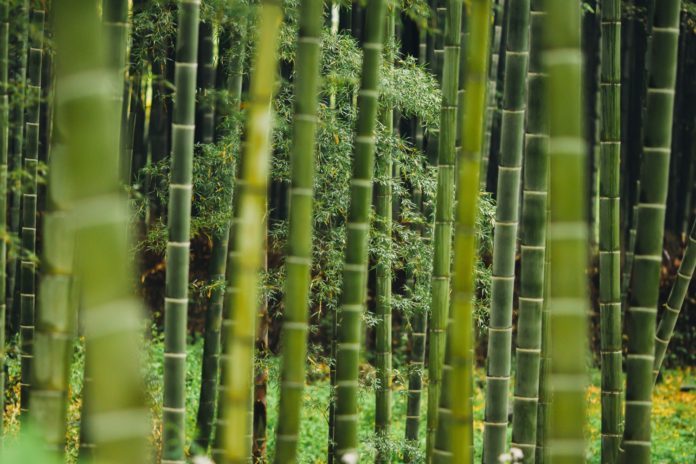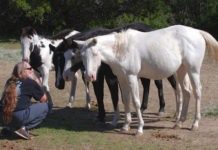Save the people, save the forest. In rural Indonesia, a pioneering clinic is showing how the health of people and forests could and should be intertwined
The roosters were still asleep when Sri Wayunisih woke her daughter, Puteri. They could not afford to sleep till dawn. Wayunisih had taken a day off from working on the oil palm estates and Puteri had skipped school for this trip. They had to reach their destination before everyone else.
Wayunisih pushed her motorcycle onto the road and her daughter climbed on behind her. The Mickey Mouse keychains on Puteri’s school bag clinked crisply. The two of them were heading towards Sukadana, a coastal district in south-west Borneo and the capital city of North Kayong, home to the only clinic in the area, some 80km away. Soon, the roosters were crowing, their calls joining the dawn prayers playing from the many suraus [Islamic assembly buildings] along the road, their walls lit only by the waning moon.
An hour and a few wrong turns later, Wayunisih and Puteri reached the clinic. The one-storey rectangular complex shone like a beacon in the dark with its white-washed walls and zinc-plated roof. Wayunisih and Puteri removed their shoes and walked up the wide stairs to the rows of green plastic chairs on its verandah. It was just past 5am. In a few hours, patients would start to queue at the clinic, and Wayunisih and Puteri would be first in line.
By 8am, a small crowd of 15 adults and children were sat on the verandah. It was Friday, the least busy day of the week. Any other weekday would see all 40 chairs on the verandah filled. It was a September morning, the end of the dry season, and some T-shirts were already moist and sticky. Out in the yard, clucking chickens pecked for food among the grass and newly planted tree seedlings. A small brown snake slithered into a bed of dry bamboo leaves. High-pitched insect humming hung in the air. On the TV, a tiger stalked its prey. Colouring books lay open on a low table. Everyone in the room sat facing the eastern wall featuring a large white sculpture of a tree growing out of dense undergrowth, hornbills flying out of its canopy, the letters ASRI carved on its trunk.
ASRI stands for Alam Sehat Lestari, Indonesian for ‘healthy nature everlasting’ or ‘harmoniously balanced’. It’s the name of an Indonesian non-profit organisation based here in North Kayong on the western border of Gunung Palung National Park. Part of West Kalimantan province, North Kayong is more than five times the area of New York City and boasts mountains, rainforests and dozens of islands. It is home to about 107,000 people, almost half of whom make a living on farms, plantations and fisheries. The monthly income averages around 2.45 million rupiah (£133), but one in ten residents make do with just 250,000 rupiah a month, much less than the World Bank’s $1 per day threshold for poverty.

The obvious fact is: people need to earn a living to survive. In desperation, many fathers and sons log and burn the edge of the national park for timber and farmland. Conservationists speak of the park’s 108,000 hectares of swamp, lowlands and montane forest, which together house sun bears, hornbills, gibbons and about 2,500 orangutans. But to local people strapped for cash, the trees look like fixed deposits to be withdrawn in entirety.
For many in North Kayong, healthcare is a dream and emergencies a nightmare. But if paying for a doctor is difficult, at least choosing one is easy: in 2016, there were only 168 nurses, 15 doctors and one dentist in the regency. Five of those doctors and that one dentist work in the clinic that Wayunisih and her daughter braved the dark road to reach, and it is here that ASRI has concentrated its efforts.
Creating alternatives to logging
Since 2007, ASRI has been working with communities around the national park to improve the wellbeing of both people and the environment. It started by setting up a clinic that provides villagers with not just the most extensive healthcare services in the area, but also incentives to stop them from logging in the park. The clinic offers up to 70 per cent discounts on medical fees to villages that stop logging, and ASRI aims for this to pile pressure on loggers to stop. Patients who cannot afford medical fees, and so might otherwise resort to illegal logging, can choose to pay with various non-cash options, including native seedlings or labour. ASRI also replants forests and trains ex-loggers to farm and run alternative businesses.
He knew so much about the forests. I have never met anyone who’s more comfortable in the forest
ASRI weaves healthcare, finances and conservation into one tapestry – a vision printed on the uniform of its conservation staff: “Masyarakat sejahtera, hutan sehat” (Prosperous society, healthy forests). This concept is now often referred to as ‘planetary health’, a term coined by the Rockefeller Foundation–Lancet Commission in 2015 to inspire research and action. But the beginnings of ASRI came more than a decade before that.
Back in 1993, when the then 21-year-old Kinari Webb first visited Gunung Palung National Park to study orangutans, the locals “had nothing” in terms of healthcare. “One of our field assistants, Pak Patin, was like a Wild Man of Borneo. He knew so much about the forests. I have never met anyone who’s more comfortable in the forest,” says Webb, a medical doctor from New Mexico, USA, and the founder of ASRI.
Discover a world of inspiration.
One day in the forest, Patin came to Webb, his eyes filled with the fear of death. “This is going to kill me,” he told her, his voice shaking. He held out his hand, bloody from a bad gash. Patin had accidentally cut his hand with his parang (machete). Webb looked at him in surprise. “OK, it is a bad cut, but it is just a cut,” she thought, “why are you so scared?” Then Webb saw what had turned the Wild Man of Borneo into mush. If you have never had a tetanus shot, no antibiotics, and you are out in the middle of nowhere where your life depends completely on your hands, losing one means losing your livelihood – and your life.
“That was what it meant to have no healthcare,” Webb says, recalling one of her many epiphanies in that first year in the forest. While she tracked orangutans in the national park, she regularly heard the sound of chainsaws in the forest. The ground shook every time a giant tree fell. Webb wondered if there would be any forest left for the orangutans she was observing. She spoke to loggers and learned that they cut and sold trees to pay for medicine. “What would you do to get healthcare? What would you do if your child is sick? Just about anything.”

A year of these encounters ended with Webb ditching her PhD plans and enrolling at Yale School of Medicine upon her return to the USA. Her studies took her from Oregon to Connecticut to California, before Webb plotted a course back to Indonesia to set up a programme combining human and environmental health. She knew the two elements were entwined, but not how such a union would look.
Meanwhile, the people of Sukadana were losing their forests faster than ever. Since the mid-1990s, loggers had attacked Gunung Palung National Park with purpose. The sound of chainsaws and falling trees penetrated the thick forest. By 2003, the threat of illegal logging forced authorities to close the research station deep inside it. Logging and farms bit and chewed at the park’s borders, eventually eating up one-fifth its forests. When Webb returned after medical school, she was amazed and relieved to find much of the park’s core still intact.

In 2006, Webb formed a team and applied to open a clinic in Sukadana. The two-month application slowed to a six-month drag but finally, in July 2007, it opened. Webb and her team went to all of the villages around the national park and conducted formal surveys – or “radical listening”, as she calls them. Leaders of farmers, fishermen and cooperatives, men and women alike, gathered to share their thoughts. ASRI asked the villagers: “You are guardians of this precious rainforest that is valuable to the whole world. What would you need as a token of gratitude from the world community?” The villagers requested two things: training in organic farming – meaning they wouldn’t have to buy expensive chemical fertilisers and pesticides – and quality healthcare that they could afford.
At 9am, Wayunisih was waiting by the room of Dr Alvita Ratnasari, a general physician. Wayunisih sat alert in her long-sleeved orange shirt and cross-stitched pink hat decorated with plastic flowers. She had dozed off waiting at the verandah and missed the first time her name was called. Beside her, Puteri wore a green surgical mask. A soft shout of “Semangat!” (Spirits up!) came from the room across the courtyard. The ASRI staff had just ended their daily meeting. Wayunisih watched as Ratnasari walked down the corridor towards her. She hoped the rumours about ASRI giving away free glasses were true, because she and her daughter hadn’t been seeing well lately.
ASRI started giving out eyeglasses in early 2007, hoping the handouts would engage the villages around Gunung Palung National Park. In those early years of the programme, there was not a day when you couldn’t hear chainsaws, says Webb. It reminded the team of the urgency of their work.
ASRI first focused on healthcare and farm training in an attempt to sever the locals’ dependence on illegal logging. Then, in 2009, they started their first reforestation project along the southern border of the national park.
Tired of divisive, scaremongering media?
I visited Laman Satong reforestation site with Jackson Helms, then the conservation research director at ASRI. Not a single bird was tweeting in the afternoon heat. The air was still, filled only with the shrill calls of insects and the crunch of dry leaves under our feet. Large trucks thundered by on the road beside the forest. Hassan*, coordinator of the site, walked in front of us. With a tinge of embarrassment, he confessed that he was once a logger. As he felled trees, he began to wonder if any would be left for his grandchildren to see, and so in 2009 he joined ASRI as a labourer and worked his way up. “Now my son helps me water and plant the seedlings on weekends,” he said, smiling. As we walked by a patch of alang-alang grass, Hassan pulled a thin stalk and played with it between his lips.
We stood on a strip of soil and gravel, a few metres wide and barren but for grasses inching in from the edges – a fire break designed to halt the advance of forest fires. Helms looked at the grasses with concern. “Grasses have grown back since we weeded them. We need more maintenance,” he said. Hassan nodded.
We left the fire break and turned into the forest. Trees stood apart in the thin undergrowth, lit by ample sunlight that broke through the sparse canopy. In a mature and undisturbed South-east Asian rainforest, thick blankets of palms, gingers and saplings would fight for every spot in the canopy’s shadow. Giant trees would rise on buttress roots that stand like walls. But this was a young and recovering forest.
Hassan pointed to the right of the trail. I squinted and spotted a thin stem…










